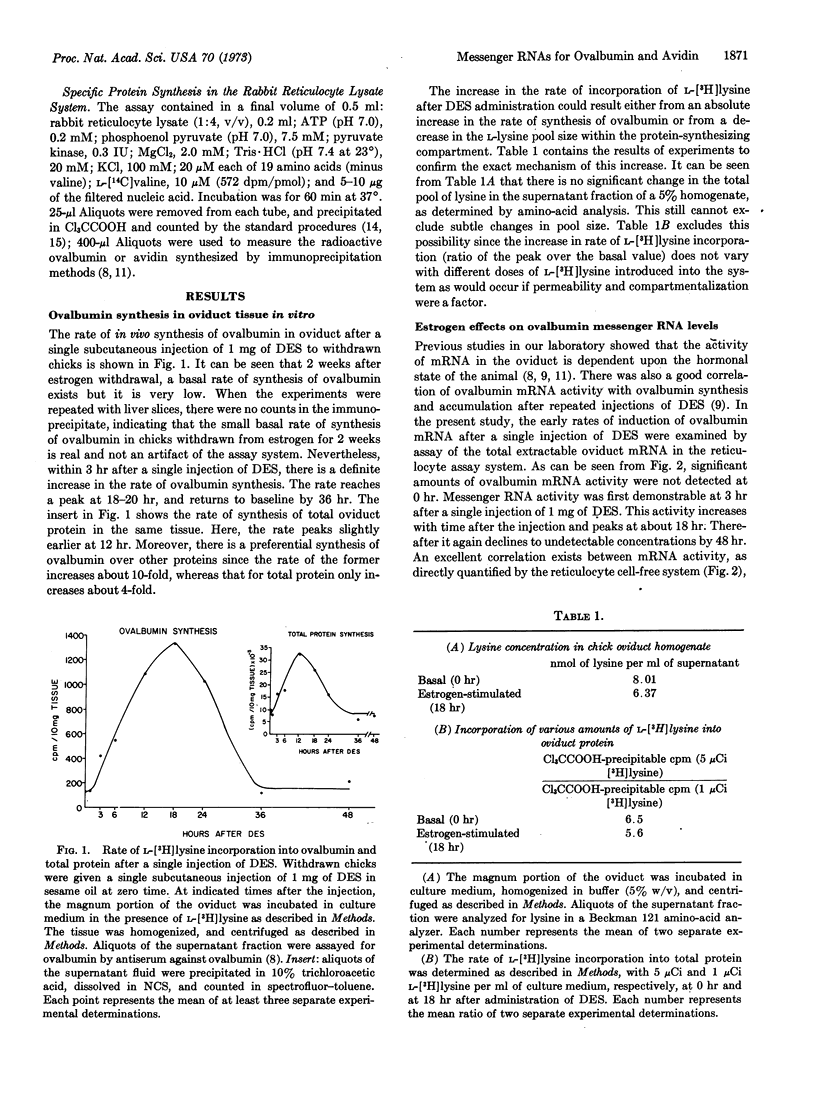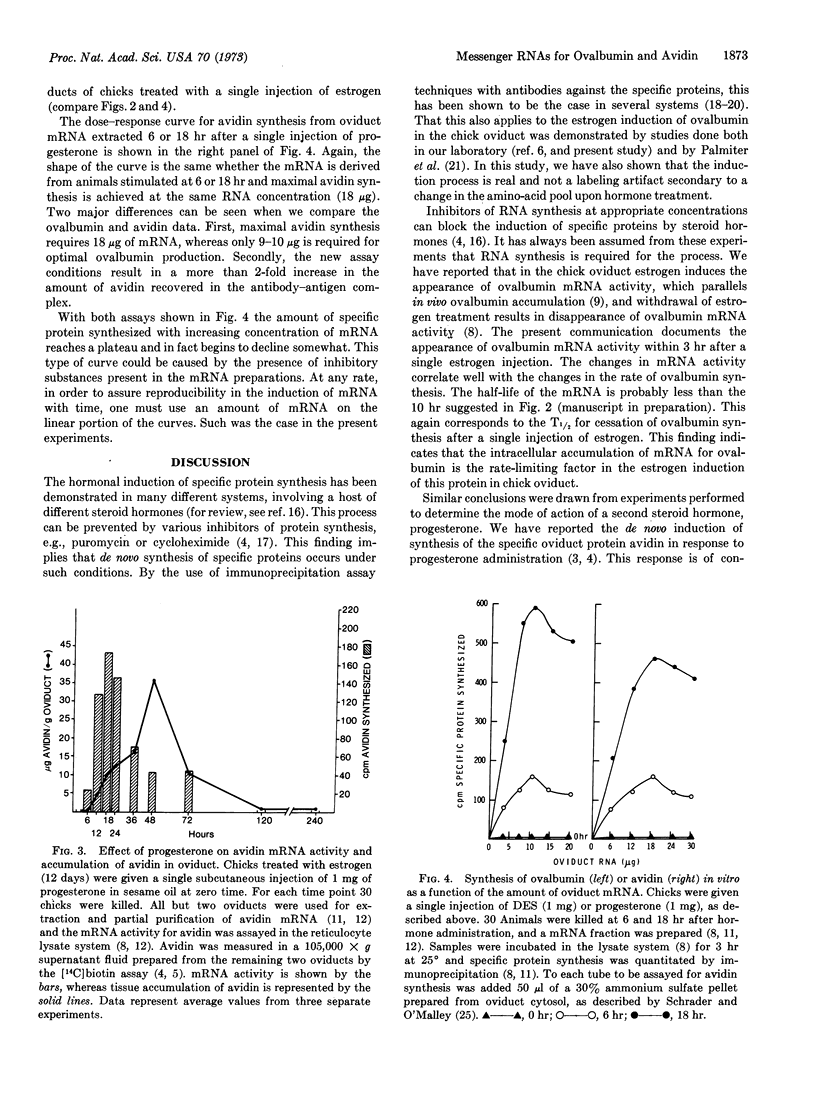Abstract
In the chick oviduct, injections of estrogen and progesterone induce synthesis of the specific proteins ovalbumin and avidin, respectively. We have studied the rate of induction of the specific messenger RNA molecules for these proteins after a single injection of estrogen or progesterone. The mRNAs were extracted, partially purified, and quantified in vitro in a heterologous protein-synthesizing system. Single injections of estrogen in chicks previously withdrawn from all steroid hormones for 2 weeks led to rapid increases in ovalbumin mRNA with 3 hr, which coincided with increases in the rate of ovalbumin synthesis. Maximal ovalbumin mRNA activity occurred by 18-20 hr. The half-life of the mRNA was estimated to be 8-10 hr and corresponded to the half-life for cessation of intracellular ovalbumin synthesis after a single injection of an estrogen. Similarly, after an injection of progesterone into chicks first treated with estrogen, appearance of avidin mRNA preceded demonstrable accumulation of this specific protein in oviduct cells. The mRNA for avidin was first apparent at 6 hr, and reached maximal concentrations between 18 and 24 hr after injection. These data confirm that both estrogen and progesterone act on oviduct to induce rapid accumulation of specific mRNAs before and coincident with the appearance of the cell-specific induced proteins. The overall results of these experiments are compatible with the hypothesis that the production of mRNA is a rate-limiting step in the steroid hormone-mediated induction of protein synthesis.
Keywords: estrogen and progesterone action, mRNA, oviduct, differentiation, protein synthesis
Full text
PDF




Selected References
These references are in PubMed. This may not be the complete list of references from this article.
- Brawerman G., Mendecki J., Lee S. Y. A procedure for the isolation of mammalian messenger ribonucleic acid. Biochemistry. 1972 Feb 15;11(4):637–641. doi: 10.1021/bi00754a027. [DOI] [PubMed] [Google Scholar]
- Comstock J. P., Rosenfeld G. C., O'Malley B. W., Means A. R. Estrogen-induced changes in translation, and specific messenger RNA levels during oviduct differentiation. Proc Natl Acad Sci U S A. 1972 Sep;69(9):2377–2380. doi: 10.1073/pnas.69.9.2377. [DOI] [PMC free article] [PubMed] [Google Scholar]
- Granner D. K., Hayashi S., Thompson E. B., Tomkins G. M. Stimulation of tyrosine aminotransferase synthesis by dexamethasone phosphate in cell culture. J Mol Biol. 1968 Jul 28;35(2):291–301. doi: 10.1016/s0022-2836(68)80025-7. [DOI] [PubMed] [Google Scholar]
- KENNEY F. T. Induction of tyrosine-alpha-ketoglutarate transaminase in rat liver. IV. Evidence for an increase in the rate of enzyme synthesis. J Biol Chem. 1962 Nov;237:3495–3498. [PubMed] [Google Scholar]
- Kohler P. O., Grimley P. M., O'Malley B. W. Estrogen-induced cytodifferentiation of the ovalbumin-secreting glands of the chick oviduct. J Cell Biol. 1969 Jan;40(1):8–27. doi: 10.1083/jcb.40.1.8. [DOI] [PMC free article] [PubMed] [Google Scholar]
- Korenman S. G., O'Malley B. W. Progesterone action: regulation of avidin biosynthesis by hen oviduct in vivo and in vitro. Endocrinology. 1968 Jul;83(1):11–17. doi: 10.1210/endo-83-1-11. [DOI] [PubMed] [Google Scholar]
- McGuire W. L., O'Malley B. W. Ribonucleic acid polymerase activity of the chick oviduct during steroid-induced synthesis of a specific protein. Biochim Biophys Acta. 1968 Mar 18;157(1):187–194. doi: 10.1016/0005-2787(68)90277-3. [DOI] [PubMed] [Google Scholar]
- Means A. R., Abrass I. B., O'Malley B. W. Protein biosynthesis on chick oviduct polyribosomes. I. Changes during estrogen-mediated tissue differentiation. Biochemistry. 1971 Apr 27;10(9):1561–1570. doi: 10.1021/bi00785a009. [DOI] [PubMed] [Google Scholar]
- Means A. R., Comstock J. P., Rosenfeld G. C., O'Malley B. W. Ovalbumin messenger RNA of chick oviduct: partial characterization, estrogen dependence, and translation in vitro. Proc Natl Acad Sci U S A. 1972 May;69(5):1146–1150. doi: 10.1073/pnas.69.5.1146. [DOI] [PMC free article] [PubMed] [Google Scholar]
- Means A. R., Hall P. F., Nicol L. W., Sawyer W. H., Baker C. A. Protein bisoynthesis in the testis. IV. Isolation and properties of polyribosomes. Biochemistry. 1969 Apr;8(4):1488–1495. doi: 10.1021/bi00832a026. [DOI] [PubMed] [Google Scholar]
- O'Malley B. W. In vitro hormonal induction of a specific protein (avidin) in chick oviduct. Biochemistry. 1967 Aug;6(8):2546–2551. doi: 10.1021/bi00860a036. [DOI] [PubMed] [Google Scholar]
- O'Malley B. W., McGuire W. L., Kohler P. O., Korenman S. G. Studies on the mechanism of steroid hormone regulation of synthesis of specific proteins. Recent Prog Horm Res. 1969;25:105–160. doi: 10.1016/b978-0-12-571125-8.50006-5. [DOI] [PubMed] [Google Scholar]
- O'Malley B. W., McGuire W. L., Korenman S. G. Estrogen stimulation of synthesis of specific proteins and RNA polymerase activity in the immature chick oviduct. Biochim Biophys Acta. 1967 Aug 22;145(1):204–207. doi: 10.1016/0005-2787(67)90679-x. [DOI] [PubMed] [Google Scholar]
- O'Malley B. W., McGuire W. L. Progesterone-induced synthesis of a new species of nuclear RNA. Endocrinology. 1969 Jan;84(1):63–68. doi: 10.1210/endo-84-1-63. [DOI] [PubMed] [Google Scholar]
- O'Malley B. W., McGuire W. L. Studies on the mechanism of estrogen-mediated tissue differentiation: regulation of nuclear transcription and induction of new RNA species. Proc Natl Acad Sci U S A. 1968 Aug;60(4):1527–1534. doi: 10.1073/pnas.60.4.1527. [DOI] [PMC free article] [PubMed] [Google Scholar]
- O'Malley B. W., Rosenfeld G. C., Comstock J. P., Means A. R. Steroid hormone induction of a specific translatable messenger RNA. Nat New Biol. 1972 Nov 8;240(97):45–48. doi: 10.1038/newbio240045a0. [DOI] [PubMed] [Google Scholar]
- Oka T., Schimke R. T. Interaction of estrogen and progesterone in chick oviduct development. II. Effects of estrogen and progesterone on tubular gland cell function. J Cell Biol. 1969 Oct;43(1):123–137. doi: 10.1083/jcb.43.1.123. [DOI] [PMC free article] [PubMed] [Google Scholar]
- Palmiter R. D., Oka T., Schimke R. T. Modulation of ovalbumin synthesis by estradiol-17 beta and actinomycin D as studied in explants of chick oviduct in culture. J Biol Chem. 1971 Feb 10;246(3):724–737. [PubMed] [Google Scholar]
- Rhoads R. E., McKnight G. S., Schimke R. T. Synthesis of ovalbumin in a rabbit reticulocyte cell-free system programmed with hen oviduct ribonucleic acid. J Biol Chem. 1971 Dec 10;246(23):7407–7410. [PubMed] [Google Scholar]
- Rosenfeld G. C., Comstock J. P., Means A. R., O'Malley B. W. A rapid method for the isolation and partial purification of specific eucaryotic messenger RNA's. Biochem Biophys Res Commun. 1972 Apr 28;47(2):387–392. doi: 10.1016/0006-291x(72)90725-5. [DOI] [PubMed] [Google Scholar]
- Rosenfeld G. C., Comstock J. P., Means A. R., O'Malley B. W. Estrogen-induced synthesis of ovalbumin messenger RNA and its translation in a cell-free system. Biochem Biophys Res Commun. 1972 Feb 25;46(4):1695–1703. doi: 10.1016/0006-291x(72)90805-4. [DOI] [PubMed] [Google Scholar]
- SCHIMKE R. T., SWEENEY E. W., BERLIN C. M. THE ROLES OF SYNTHESIS AND DEGRADATION IN THE CONTROL OF RAT LIVER TRYPTOPHAN PYRROLASE. J Biol Chem. 1965 Jan;240:322–331. [PubMed] [Google Scholar]
- Schrader W. T., O'Malley B. W. Progesterone-binding components of chick oviduct. IV. Characterization of purified subunits. J Biol Chem. 1972 Jan 10;247(1):51–59. [PubMed] [Google Scholar]
- Thompson E. B., Tomkins G. M., Curran J. F. Induction of tyrosine alpha-ketoglutarate transaminase by steroid hormones in a newly established tissue culture cell line. Proc Natl Acad Sci U S A. 1966 Jul;56(1):296–303. doi: 10.1073/pnas.56.1.296. [DOI] [PMC free article] [PubMed] [Google Scholar]
- Tomkins G. M., Levinson B. B., Baxter J. D., Dethlefsen L. Further evidence for posttranscriptional control of inducible tyrosine aminotransferase synthesis in cultured hepatoma cells. Nat New Biol. 1972 Sep 6;239(88):9–14. doi: 10.1038/newbio239009a0. [DOI] [PubMed] [Google Scholar]


